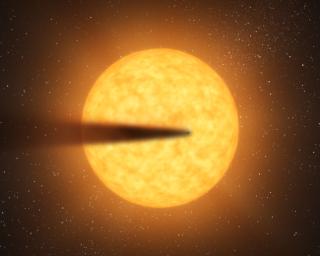
|
Possible Disintegrating Planet (Artist’s Concept)
- Click the image above for a larger view
- Full-Res JPEG (1500 x 1200) (116.9 kB)
- Full-Res TIFF (1500 x 1200) (5.4 MB)
Caption:
This artist's concept depicts a comet-like tail of a possible disintegrating super Mercury-size planet candidate as it transits, or crosses, its parent star, named KIC 12557548. The results are based on data from NASA's Kepler mission.
At an orbital distance of only twice the diameter of its star, the surface temperature of the potential planet is estimated to be a sweltering 3,300 degrees Fahrenheit (1,816 degrees Celsius). At such a high temperature, the surface would melt and evaporate. The energy from the resulting wind would be enough to allow dust and gas to escape into space creating a trailing dusty effluence that intermittently blocks the starlight.
Background Info:
NASA's Ames Research Center in Moffett Field, Calif., manages Kepler's ground system development, mission operations and science data analysis. JPL managed the Kepler mission's development.
For more information about the Kepler mission, visit: http://www.nasa.gov/kepler .
Cataloging Keywords:
| Name | Value | Additional Values |
|---|---|---|
| Target | KIC 12557548 | |
| System | KIC 12557548 | |
| Target Type | Exoplanet | |
| Mission | Kepler | |
| Instrument Host | Kepler | |
| Host Type | Space Telescope | |
| Instrument | ||
| Detector | ||
| Extra Keywords | Artwork, Color, Dust, Infrared, Orbit | |
| Acquisition Date | ||
| Release Date | 2012-05-21 | |
| Date in Caption | ||
| Image Credit | NASA/JPL-Caltech | |
| Source | photojournal.jpl.nasa.gov/catalog/PIA15629 | |
| Identifier | PIA15629 | |
